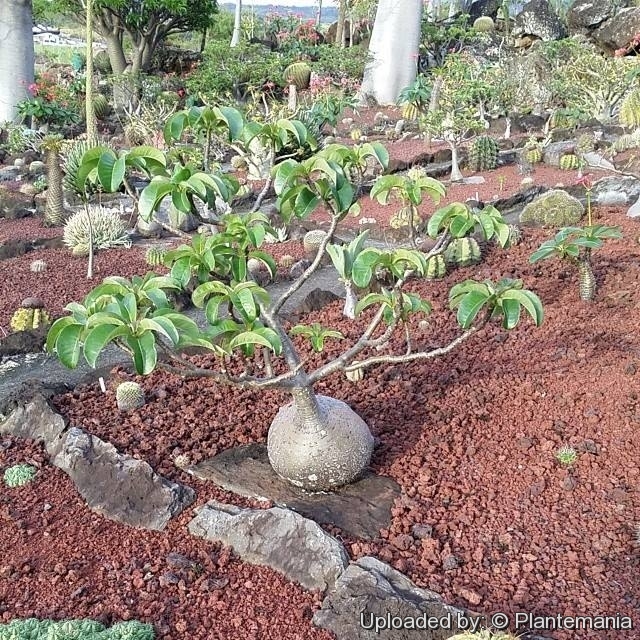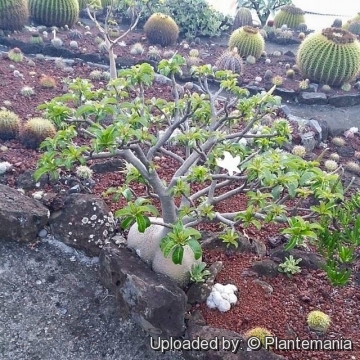




Your support is critical to our success.
- Encyclopedia of SUCCULENTS
- Encyclopedia Index
- Families
- Genera
- Species
- Apocynaceae
- Pachypodium
- Caudiciforms
Since 4 Aug 2013

It is rare in cultivation, probably because it is very slow growing.
Origin and Habitat: Pachypodium decaryiSN|14816]]SN|14811]] is native to central Madagascar (Falaise d'Ankarana, Montagne des Francais).
Altitude: Alt. 200-400 metres above sea level.
Habitat and ecology: Strongly eroded limestone rocks in sunny places. It grows in dry deciduous forest with scattered evergreens, which covers the top of the limestone massif in Ankarana Special Reserve On limestone plateaux in deciduous forest the plants are taller and slimmer than those on the floodplains, but flowers are similar throughout. Accompanied by Pachypodium windsoriiSN|14807]]SN|14807]], Pachypodium rutenbergianumSN|14811]]SN|14816]], Euphorbia aureo-viridiflora, Euphorbia pachypodioides, Talinella sp., Uncarina peltataSN|28285]]SN|28285]], Impatiens tuberosaSN|33451]]SN|33451]], Aloe suarezensis and Cyphostemma sakalavense.
Synonyms:
- Pachypodium decaryi Poiss.
CHINESE (中文): 迪氏棒錘樹
Description: Pachypodium decaryiSN|12217]]SN|14811]] a pachycaul shrub that can eventually reach a height of nearly 2 meters (occasionally 4 metres), and develop a vastly expanded, swollen, water-filled trunk (caudex) with few smooth branches like Adenium. It blooms with white flowers that recall those of Pachypodium lamereiSN|10823]]SN|10823]] and Pachypodium lealiiSN|14811]]SN|12217]], but can be even larger, 5-8 cm long and up to12 cm in spread.
Unique in the genus for the nearly complete absence of spines and the largest flowers of all, but regrettably rare and difficult to keep in cultivation.
Stem: Swollen base (caudex) massive, swollen, almost spherical up to 40 cm in diameter, grey skinned grey skinned abruptly tapering above into a few relatively thin, smooth branches that can grow up to two or four meter bearing leaves in terminal rosettes.
Spines: In groups of 3 on the new stem tips. They are minute and black, and drop soon with the leaves.
Leaves. Shortly petiolate, 5-8(-10) cm long, 3.5-5 cm wide, elliptic-acuminate, finely hairy beneath at the margins
Inflorescences: Flowers up to 10 in terminal clusters.
Flowers: Salverforrn, white, 5-8 cm long, to 12 cm in diameter, tube 6 mm in diamete.
Fruits (follicles):Erect, curved from the base, 22 cm, 1 cm diameter.
Seeds: 1 cm long.
Bibliography: Major references and further lectures
1) Gordon D. Rowley “Pachypodium and Adenium” Cactus File, Cirio Pub. Services, 1999
2) Urs Eggli “Illustrated Handbook of Succulent Plants: Dicotyledons” Springer Science & Business Media, 2002
3) S. H. J. V. Rapanarivo “Pachypodium (Apocynaceae)” CRC Press, 01 June 1999
4) Werner Rauh, Herman Schwartz “Succulent and xerophytic plants of Madagascar”, Volume 2 Strawberry Press, 1998
5) Wikipedia contributors. "Pachypodium decaryi." Wikipedia, The Free Encyclopedia. Wikipedia, The Free Encyclopedia, 6 Dec. 2016. Web. 6 Dec. 2016.

Growing habit at Réunion. Photo by: © Plantemania
The gallery now contains thousands of pictures, however it is possible to do even more. We are, of course, seeking photos of species not yet shown in the gallery but not only that, we are also looking for better pictures than those already present. Read More...
Cultivation and Propagation: Pachypodium decaryiSN|14811]]SN|14811]] is one of the most attractive species in the entire genus that can be grown both indoors, as well as outdoors in warm climates. It’s a rare and slow growing species and an impressive caudex can be developed over the years. In the winters it is deciduous. Pretty cold sensitive- supposedly prone to rot if wet in winter cold. It may be grown as a specimen among rocks and low-growing plants in a hot rockery. It may also be grown in a heavy container on the sunny patio.
Soil: Needs a gritty, porous cactus potting mix that's not strongly acidic.
Watering: Water sparingly in the heat of the growing season to encourage new growth, foliage and flowering, and give extra well-drained soil to avoid waterlogged conditions, no water from late autumn to mid-spring. The watering program will change depending on temperatures and stage of growth, but it is best not to let this plant dry out completely for any length of time. Indoors it is best to keep it on the dry side, or it is prone to rot. Outdoors it must be protected from the rain in winter. Do not let this specimen sit damp in cool weather. The older it gets the less water it must receive!
Hardiness: It is sensitive to cold and should be kept totally dry in winter. Wintering: nocturnal 16°C and diurnal 20°C or more, but it demonstrates some cold resilience if dormant and the soil is bone dry in winter. Protect from frost. It tends to lose its leave and go dormant in winter (USDA Hardiness zones: 10 – 11).
Exposure: It like full sun to light shade.
Maintenance: This Pachypodium will not require any pruning to look like a very interesting and unusual bonsai, but after several years it can outgrow its indoor location, requiring a 'pruning'. It has amazing regenerative properties.
Repot: Repot the plant every 3 years; this is quite tricky given all the spines. The best way is to wrap several layers of newspaper around the trunk where it is to be handled.
Propagation: Seeds or (rarely) cuttings. Fresh seeds results in a remarkable yield of new plants, perhaps 90% and seedlings grow fairly easily. Soak seeds in warm water for 24 hours before sowing in a 5 mm deep, sterile, moist sandy medium (4 parts fine and 4 parts coarse river sand 1 part sieved, well-rotten compost; 1 part perlite; 1 part vermiculite. Keep the mix moist and at a temperature of 27–35°C to ensure rapid germination. Seed start sprouting in just 3-4 days ( but continue to germinate erratically for about 6 month) they are also propagated by removal of branches from old plant (if they need to be pruned). They should be allowed to dry for 5 to 8 days before potting up, however the cuttings often fail to root. Seedlings grow fairly slowly compared to other Pachypodium species. Young plants have more conical spines and begin early to swell nicely, branch and even flower.
| Your Actions | |
|---|---|
| Back to Pachypodium index | |
| Back to Apocynaceae index | |
 |
Back to Succulents Encyclopedia index |
Privacy stantement - Terms and conditions - How to cite - About us - Feedback - Donate



